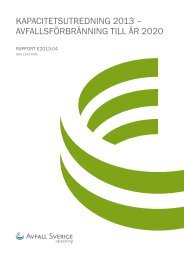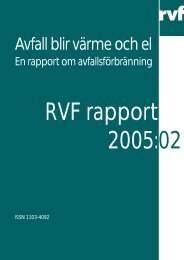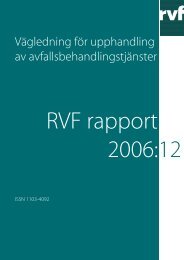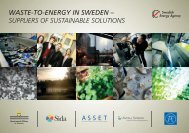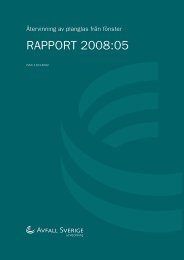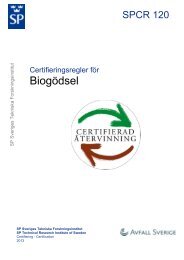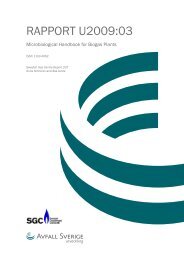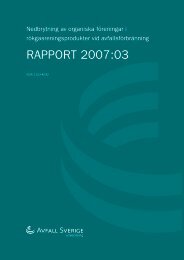Metoder att mäta och reducera emissioner från ... - Avfall Sverige
Metoder att mäta och reducera emissioner från ... - Avfall Sverige
Metoder att mäta och reducera emissioner från ... - Avfall Sverige
Create successful ePaper yourself
Turn your PDF publications into a flip-book with our unique Google optimized e-Paper software.
ABSTRACT<br />
5<br />
The aim of this study is to evaluate and test different instruments and methods to<br />
measure emissions from systems with digestion and upgrading. Further, the purpose is<br />
to estimate the magnitude of these emissions and to understand where in the plants they<br />
arise, which will be made through measurements. Finally suggestions will be made<br />
about how to reduce the emissions. The study is commissioned by BUS with<br />
Renhållningsverksföreningen as project manager.<br />
Five types of instruments were tested and evaluated: Conventional leak detector, Laser<br />
Pointer, FID, FTIR and samples analysed with gas chromatography. The measurements<br />
took place on two biogas plants and three upgrading plants in Sweden. Every plant uses<br />
a different technology and have different raw material for their activity, which is<br />
assumed to make them a representative selection of the Swedish plants.<br />
The measurements are random samples but indicate that the largest leakages of methane<br />
originate from the upgrading plants and that the size of these discharges strongly varies<br />
with upgrading technology. Except for methane, laughing gas, alcohols and sulphur<br />
compounds among others, have been detected on digestion plants. Laughing gas and<br />
sulphur compounds are assumed to be formed in the hygienisation. There is a good<br />
potential though, to reduce the emissions on both biogas and upgrading plants.<br />
Examples of measures which reduce the emissions from systems of digestion and<br />
upgrading of biogas is:<br />
• Strive for having as much as possible of the plants indoors, to be able to survey<br />
and treat the emissions in the ventilation air.<br />
• Make the heating period as short as possible in the hygienisation, in order to<br />
reduce the formation of laughing gas and sulphur compounds.<br />
• Use leak detectors regularly on the plants to discover and <strong>att</strong>end to diffusive<br />
leakages, for both environmental and security reasons.<br />
• Continuously measure the content of methane in the gas flow leaving the plant<br />
to atmosphere. This gives the possibility to optimise the operation regarding to<br />
the losses of methane.<br />
• Destruct the methane in the gas leaving the plant to atmosphere by<br />
oxidizing/combusting it, e.g. thermically or catalytically.





